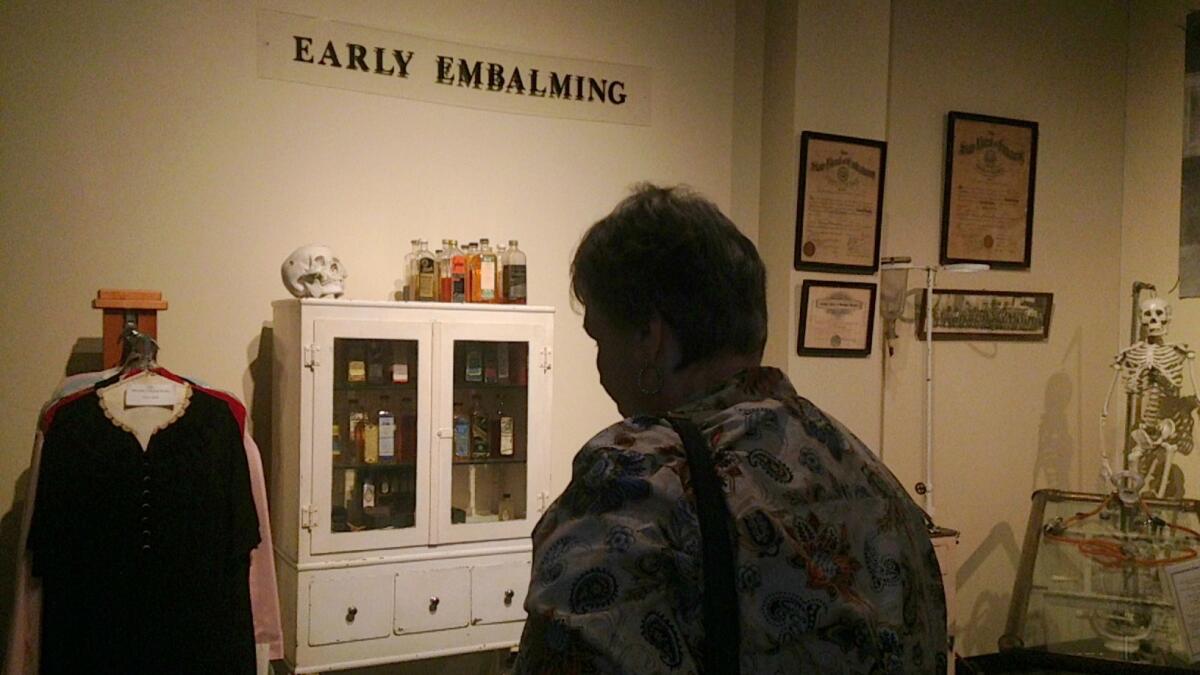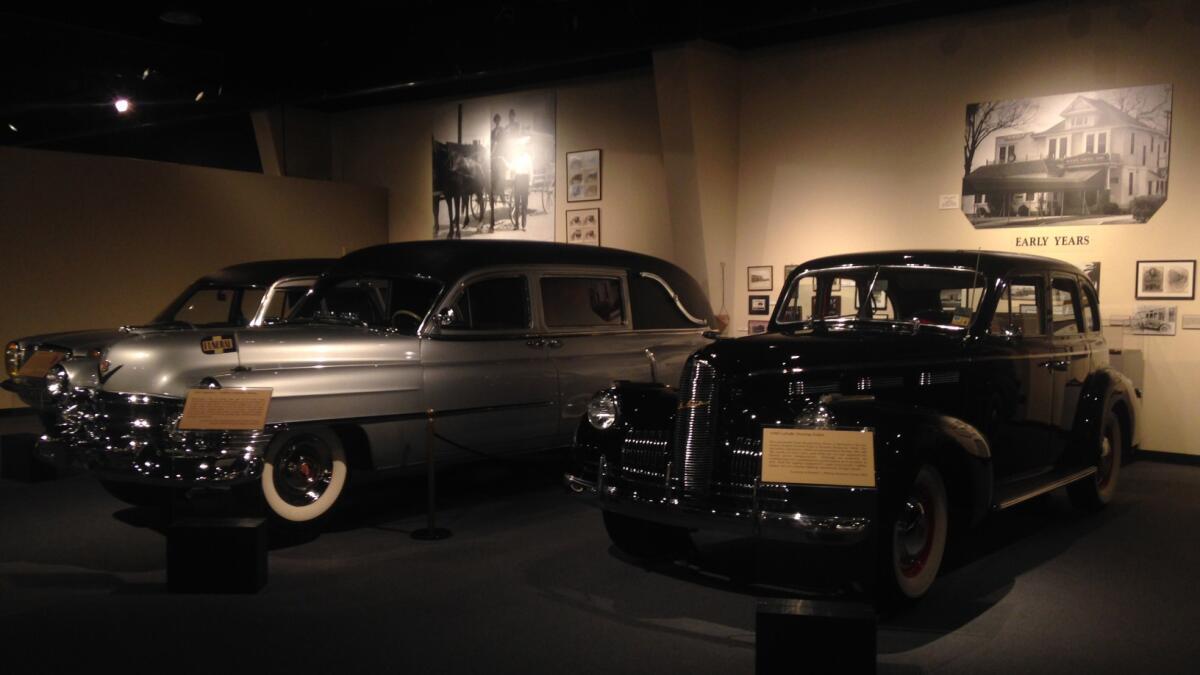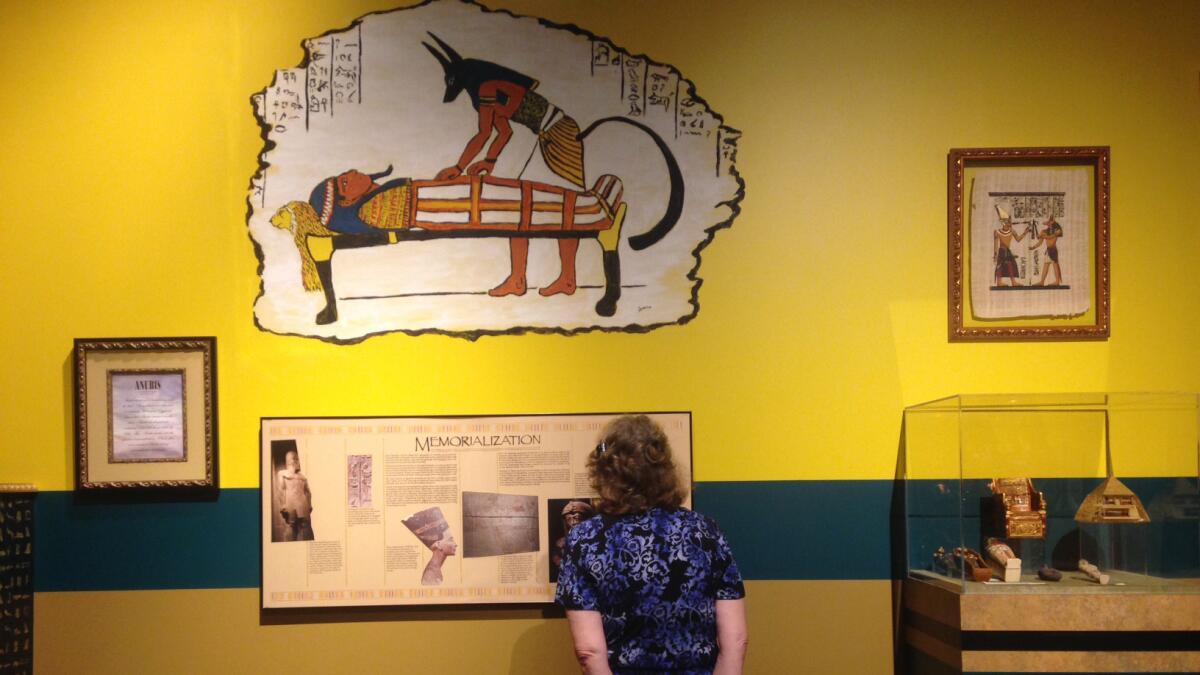At a Houston museum filled with coffins and hearses, it’s time for ‘Death 101’

Linda Gravelle stared into the hearse. Thirty seconds went by and she lifted her camera, wanting to remember the moment.
“Wow,” she whispered. “So beautiful.”
But it wasn’t a departed loved one that gripped her attention. It was a small, horse-drawn carriage from 1832 — one of several early-model hearses on display inside a huge brick building in north Houston.
The National Museum of Funeral History is for those of us who don’t mind contemplating death. At 66, Gravelle knows her sun is setting, but she and her husband aren’t afraid of reminders. After all, their pastor back home in Washington state sometimes holds services in a funeral home.
Full-time RVers, the couple saw a pamphlet for the museum at a Texas welcome center near the Louisiana border and decided to stop in.
Every year, about 20,000 people visit the museum, which was founded in 1992 by Houston mogul Robert Waltrip, the founder of Service Corporation International — the largest funeral home chain in the country.
“We don’t get Death 101 in school,” said Genevieve Keeney, the museum’s president. “My goal is to get people to embrace death. If you can embrace it, you can live a fuller life.”
Once you’ve walked through the gift shop, where you can buy a T-shirt emblazoned with the museum’s motto — “Any day above ground is a good one” — the museum opens up into more than 30,000 square feet of exhibition space. It’s dimly lit except for the spotlights beaming down on row after row of coffins and hearses.
On a recent morning, a group of elderly women paused for photos in front of a Mercedes hearse used in Grace Kelly’s funeral and later in front of a casket covered in coins and dollar bills — a reminder, they joked, that you can take your money with you to the grave.

While the collection touts many items tied to the rich and famous, including a $450 funeral bill sent to the White House after Franklin D. Roosevelt’s death and a replica of Pope John Paul II’s crypt, the items of lesser known people often get the most attention.
Take, for example, a copy of the program from the 2011 memorial service for Arch West, who worked at Frito-Lay and helped invent Doritos corn chips.
“Good dude,” one visitor said, posing for a picture with his thumb up near the display case.
On the other side of the museum, a woman with tattoos covering her calves scrolled through her phone looking a bit bored.
She was on vacation from Pennsylvania and had picked the museum from a list of activities her mother-in-law had offered up. But she found herself wishing that the $10 entrance would bring something “a little creepier” than dead popes and presidents.
Her husband walked over smiling. “I found the good stuff,” he told her. “An embalming exhibit.”
They inspected a bottle of old, yellow liquid whose label boasted of being “valuable in emaciated cases” and a two-pronged metal contraption that looked like a weapon but was actually used to curl the hair of dead people in the 1940s.
It may be impossible to think about death without thinking about your own.
Abigail Hein, 40, a stamp dealer from Concord, Calif., who discovered the museum on a website of “curious places,” took a selfie with a statue in the pope exhibit.
She posted it on Facebook with the caption: “When I go, you can do whatever you want with my remains.”
One item in particular stuck with her: a coffin from Ghana that was shaped like a lobster. “I wouldn’t want anyone to put it in the ground, though,” she said. “Too beautiful.”
Hein figures she’ll be cremated like other members of her family — and that perhaps, her ashes could go into the ground and help nourish a tree.
Keeney, 46, said that while quirkiness raises the profile of the museum profile — it was featured on both A&E “Shipping Wars” and Ozzy Osbourne’s show on the History Channel — portraying the place merely as an oddity undermines its serious work.

For its latest exhibit, created for the fifteenth anniversary of the Sept. 11 terrorist attacks, the museum created mini twin towers by stacking dozens of memorial register books. Waltrip’s funeral homes had put them out on Sept. 12, 2001, as a way to allow people to express their grief.
For Keeney, whose predominantly black wardrobe belies a chipper spirit, working at the museum fulfills a lifelong goal. Her fascination with death started at age 7 when she heard a television news segment about an infant found in a trash can.
“Wow, what would that baby look like?” she recalls thinking. “What does death look like?”
For career day in high school, Keeney interviewed a coroner, who let her see a photograph of a person who had drowned. But it wasn’t until she was 28 and living in Germany as a medic in the U.S. Army that she first saw a dead body — that of a soldier found in his room.
Another time in Germany, while walking the hallway of a morgue where she was planning to observe an autopsy, Keeney heard a man singing quietly. She walked into the room and realized the man had been singing a lullaby to a dead infant. He turned out to be a funeral director.
“I want to be what you are,” she told him.
Back in the U.S., she did just that.
Few things animate her like working around death. Her pale blue eyes lit up when speaking about an upcoming exhibit: The History of Cremation.
“I personally love cremation,” she said.
More to Read
Start your day right
Sign up for Essential California for news, features and recommendations from the L.A. Times and beyond in your inbox six days a week.
You may occasionally receive promotional content from the Los Angeles Times.







